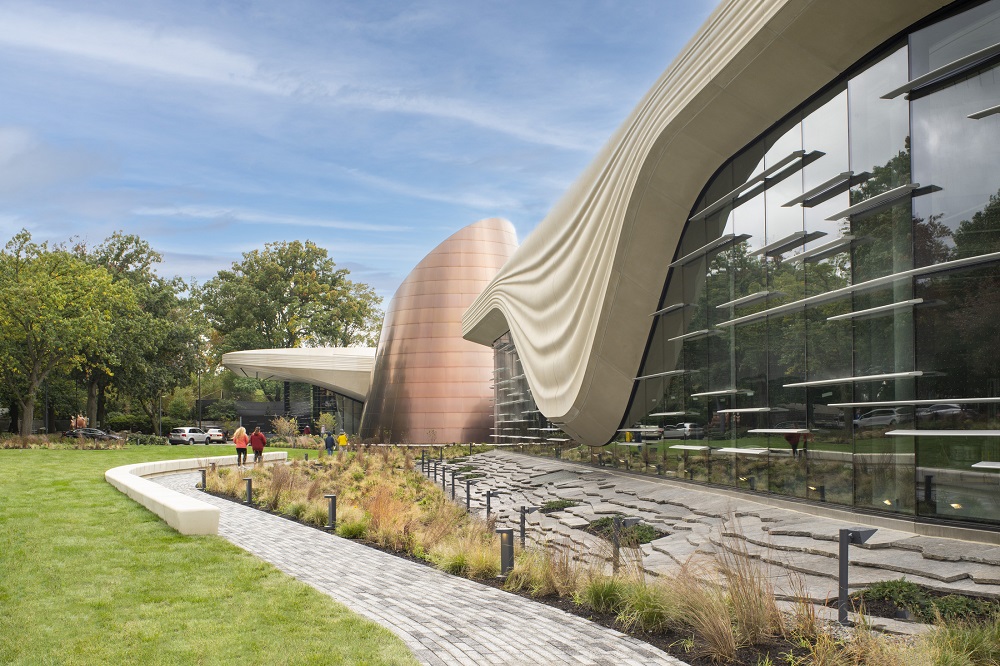Cleveland Museum Earns Top Green Building Certification
The Cleveland Museum of Natural History, in partnership with DLR Group, has achieved one of highest honors in sustainable building design, becoming the first museum in the United States to earn LEED v4 BD+C NC Platinum certification.
A prestigious status designated by the U.S. Green Building Council (USGBC), LEED, or Leadership for Energy and Environmental Design, is “the international standard for the design, construction, and operation of high-performance structures.” LEED Platinum represents the USGBC’s top certification.

“As a leading cultural institution and a champion of a better future for both humans and the planet, the museum’s new architecture reflects its mission,” said Sonia Winner, museum president and CEO.
“With LEED Platinum certification, the museum sets a new standard for natural history museums,” added DLR Group Principal and Global Architecture Leader Joshua Haney. “Using the past to inform our present to build a better future combined with a collaborative strategy, we produced a beautiful, energy-efficient building that elevates the human experience through design.”
Transformation
The Cleveland Museum of Natural History’s $150 million transformation project began in early 2020 and was completed in spring 2024. The project reimagined an existing 217,250 square-foot facility, located prominently within Cleveland’s cultural district, to more than 375,000 square feet with more than 2 acres of outdoor visitor areas. The project included a new visitor hall, lobby, and exhibit wing with completely new exhibits that break away from traditional museum compartmentalization by time period and scientific discipline. Instead, the museum’s reconceptualized exhibits present an integrated storyline of planetary and biological processes that aim to make these powerful forces tangible and relevant to contemporary life. The museum held its official grand opening in December.
Pathways to LEED Platinum Certification
Working together and with consultant partners for landscape and civil design, DLR Group employed several passive and active sustainable design strategies to achieve LEED Platinum certification.
Visible Sustainability
The museum’s mission for the transformation project was to educate the community on how humans are connected to and impact the natural environment. In response, DLR Group designed a sustainability feature to be on display and spark curiosity for visitors by activating the primary façade of the new wing. During rain events, stormwater runoff is reduced by capturing rainfall from the roof via a gutter that daylights stormwater through the GFRC cladding onto the alvar stone outcropping below. A rain garden with native plants reduces stormwater runoff by absorbing rainfall from the roof.
Key Sustainable Highlights:
- Water Management: In addition to the visible stormwater runoff, plumbing fixtures reduce indoor potable water use by 37%.
- Restoration and Wildlife Protection: Restoring over 50% of the site with native vegetation and trees reduced outdoor potable water use by 60%, mitigated heat island effects, and supported pollinators and birds. Bird-friendly glass and minimized light pollution protect wildlife.
- Energy Efficiency: A mix of passive strategies (low-e glazing, R-30 roof insulation, shading) and active systems (HVAC plant with efficient heat recovery chiller, solar photovoltaic arrays) reduced energy use by 32% compared to ASHRAE 90.1-2010 standards. Post-occupancy monitoring is in place to optimize performance.
- Carbon Reduction: A Building Life-Cycle Impact Reduction study showed a greater than 10% reduction in embodied carbon for the new spaces.
- Sustainable Materials: The project diverted over 75% of construction waste from landfills, and interior designers prioritized materials with environmental product declarations (EPDs) and verified sourcing.
- Indoor Environmental Quality: Low-VOC materials, optimized acoustics, and daylight access for 95% of occupied spaces enhance comfort and health.
The post Cleveland Museum Earns Top Green Building Certification appeared first on Facilities Management Advisor.

